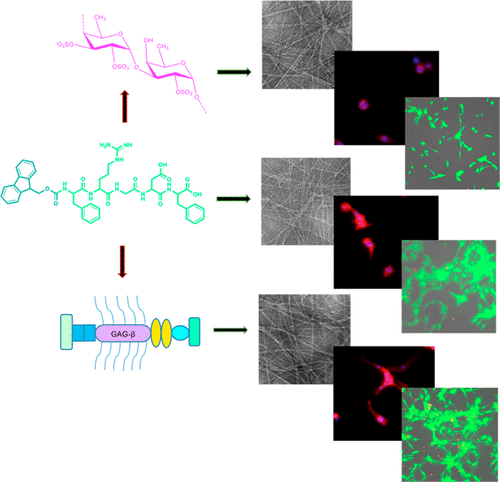当前位置:
X-MOL 学术
›
Biomacromolecules
›
论文详情
Our official English website, www.x-mol.net, welcomes your feedback! (Note: you will need to create a separate account there.)
Large and Small Assembly: Combining Functional Macromolecules with Small Peptides to Control the Morphology of Skeletal Muscle Progenitor Cells
Biomacromolecules ( IF 6.2 ) Pub Date : 2018-02-01 00:00:00 , DOI: 10.1021/acs.biomac.7b01632 Rui Li 1, 2 , Natasha L. McRae 3 , Daniel R. McCulloch 3 , Mitchell Boyd-Moss 4, 5 , Colin J. Barrow 1 , David R. Nisbet 4, 6 , Nicole Stupka 3 , Richard J. Williams 4, 5
Biomacromolecules ( IF 6.2 ) Pub Date : 2018-02-01 00:00:00 , DOI: 10.1021/acs.biomac.7b01632 Rui Li 1, 2 , Natasha L. McRae 3 , Daniel R. McCulloch 3 , Mitchell Boyd-Moss 4, 5 , Colin J. Barrow 1 , David R. Nisbet 4, 6 , Nicole Stupka 3 , Richard J. Williams 4, 5
Affiliation

|
The material properties of natural tissues, such as skeletal muscle, are highly sophisticated and are synthetically challenging to mimic. Using natural biomacromolecules to functionalize self-assembled peptide (SAP) hydrogels has the potential to increase the utility of these materials by more closely reproducing the natural cellular environment. Here, to demonstrate that a conserved co-assembly pathway can retain distinct function, the biocompatible peptide derivative Fmoc-FRGDF was co-assembled with either a sulfated polysaccharide, fucoidan, or the provisional matrix proteoglycan, versican. Our results demonstrate that thermodynamically driven co-assembly with biologically active macromolecules is facile, stable, and does not affect the final assembled nanostructure. Biologically, the incorporation of these functionally distinct molecules had no effect on C2C12 myoblast proliferation and viability but strongly altered their morphology. The surface area of myoblasts cultured on the fucoidan scaffold was reduced at 24 and 72 h post seeding, with a reduction in the formation of multinucleated syncytia. Myoblasts cultured on versican scaffolds were smaller compared to cells grown on the empty vector scaffolds at 24 h but not 72 h post seeding, with multinucleated syncytia formation being unaffected. This work allows programmed and distinct morphological effects of cell behavior, paving the way for further mechanistic studies.
中文翻译:

大型装配和小型装配:将功能性大分子与小肽结合以控制骨骼肌祖细胞的形态
天然组织(例如骨骼肌)的材料特性非常复杂,并且在模仿时具有合成挑战性。使用天然生物大分子功能化自组装肽(SAP)水凝胶具有通过更紧密地复制天然细胞环境来增加这些材料的实用性的潜力。在这里,为了证明保守的共组装途径可以保留独特的功能,将生物相容性肽衍生物Fmoc-FRGDF与硫酸化多糖岩藻依聚糖或临时基质蛋白聚糖(versican)共组装。我们的结果表明,具有生物活性大分子的热力学驱动的共组装是便捷,稳定的,并且不会影响最终组装的纳米结构。从生物学上讲 这些功能独特的分子的结合对C2C12成肌细胞的增殖和生存力没有影响,但强烈改变了它们的形态。接种后24和72小时,在岩藻依聚糖支架上培养的成肌细胞的表面积减少,多核合胞体的形成减少。与在空载体支架上生长的细胞相比,在接种后24小时而非在接种后72小时,在versican支架上培养的成肌细胞更小,多核合胞体的形成不受影响。这项工作使细胞行为受到程序化和独特的形态学影响,为进一步的机理研究铺平了道路。减少多核合胞体的形成。与在空载体支架上生长的细胞相比,在接种后24小时而非在接种后72小时,在versican支架上培养的成肌细胞更小,多核合胞体的形成不受影响。这项工作使细胞行为受到程序化和独特的形态学影响,为进一步的机理研究铺平了道路。减少多核合胞体的形成。与在空载体支架上生长的细胞相比,在接种后24小时而非在接种后72小时,在versican支架上培养的成肌细胞更小,多核合胞体的形成不受影响。这项工作使细胞行为受到程序化和独特的形态学影响,为进一步的机理研究铺平了道路。
更新日期:2018-02-01
中文翻译:

大型装配和小型装配:将功能性大分子与小肽结合以控制骨骼肌祖细胞的形态
天然组织(例如骨骼肌)的材料特性非常复杂,并且在模仿时具有合成挑战性。使用天然生物大分子功能化自组装肽(SAP)水凝胶具有通过更紧密地复制天然细胞环境来增加这些材料的实用性的潜力。在这里,为了证明保守的共组装途径可以保留独特的功能,将生物相容性肽衍生物Fmoc-FRGDF与硫酸化多糖岩藻依聚糖或临时基质蛋白聚糖(versican)共组装。我们的结果表明,具有生物活性大分子的热力学驱动的共组装是便捷,稳定的,并且不会影响最终组装的纳米结构。从生物学上讲 这些功能独特的分子的结合对C2C12成肌细胞的增殖和生存力没有影响,但强烈改变了它们的形态。接种后24和72小时,在岩藻依聚糖支架上培养的成肌细胞的表面积减少,多核合胞体的形成减少。与在空载体支架上生长的细胞相比,在接种后24小时而非在接种后72小时,在versican支架上培养的成肌细胞更小,多核合胞体的形成不受影响。这项工作使细胞行为受到程序化和独特的形态学影响,为进一步的机理研究铺平了道路。减少多核合胞体的形成。与在空载体支架上生长的细胞相比,在接种后24小时而非在接种后72小时,在versican支架上培养的成肌细胞更小,多核合胞体的形成不受影响。这项工作使细胞行为受到程序化和独特的形态学影响,为进一步的机理研究铺平了道路。减少多核合胞体的形成。与在空载体支架上生长的细胞相比,在接种后24小时而非在接种后72小时,在versican支架上培养的成肌细胞更小,多核合胞体的形成不受影响。这项工作使细胞行为受到程序化和独特的形态学影响,为进一步的机理研究铺平了道路。


























 京公网安备 11010802027423号
京公网安备 11010802027423号